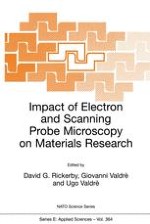1999 | OriginalPaper | Buchkapitel
ESEM Image Contrast and Applications to Wet Organic Materials
verfasst von : Athene M. Donald, Bradley L. Thiel
Erschienen in: Impact of Electron and Scanning Probe Microscopy on Materials Research
Verlag: Springer Netherlands
Enthalten in: Professional Book Archive
Aktivieren Sie unsere intelligente Suche, um passende Fachinhalte oder Patente zu finden.
Wählen Sie Textabschnitte aus um mit Künstlicher Intelligenz passenden Patente zu finden. powered by
Markieren Sie Textabschnitte, um KI-gestützt weitere passende Inhalte zu finden. powered by
In the Environmental Scanning Electron Microscope (ESEM) there is a gas in the chamber above the sample. This is the crucial difference between it and conventional scanning electron microscopy (CSEM), which permits a wide range of samples to be investigated of a type inaccessible to CSEM. When the gas is water vapour, then damp/wet samples (or even essentially pure water) can be investigated without the need for careful prior specimen preparation to remove all the liquid. This obviously has the advantage that reduction in specimen preparation means a reduction in the liklihood of artefacts being introduced. However, the presence of the gas leads to a variety of new effects due to the interaction of the electrons with the gas molecules. Some of these effects are desirable and, as we will see below, can be usefully harnessed to provide novel sources of contrast. However, other consequences are less desirable, leading to both a reduction in spatial resolution and signal/noise ratio. Hence, in order to optimise use of the ESEM, it is important to have a clear understanding of the nature of the potential gas molecule/electron interactions, and their impact on image formation.
